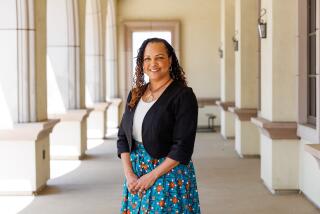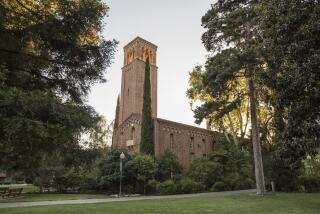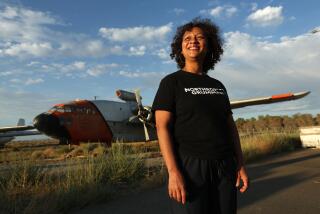GOING IS ROUGH FOR S.D. COLLEGE RADIO STATIONS
- Share via
SAN DIEGO — Last week San Diego State University’s campus radio station, KCR, nearly went off the air.
The finance committee of the school’s Associated Students Council had recommended that the council immediately cut off funding to KCR because of the 17-year-old station’s continual debts.
Finance committee members said the crux of the problem is anemic commercial sales because of its few listeners, and a lack of strong management because of a high turnover of staff.
But while KCR may have been saved, at least temporarily, by the success of an 11th-hour appeal before the full council for continued funding of $9,000 a year, the problems have by no means been solved.
Most of San Diego’s five college radio stations, which all boast eclectic formats not normally heard on commercial stations, share those difficulties: How do you boost listenership, and thus advertising revenue, when you are denied access to the public airwaves, and how can you have strong management when most of your staff changes from semester to semester?
The first problem is unique to towns like San Diego adjacent to the border with Mexico, said June Butler, a public service specialist with the Federal Communications Commission (FCC).
When FM first went stereo in 1961, Butler said, there arose a high demand for FM frequency allocations. The FCC decided to reserve the lower frequencies, from 87.9 to 91.9, for college and other non-commercial or educational radio stations, she said. This arrangement has worked well for college stations in most radio markets, Butler said.
“But in border towns like San Diego, an FCC agreement with the Mexican government also calls for Mexican radio stations broadcasting into the United States to use those very same lower frequencies,” Butler said. “And that means there are going to be problems, since there’s not enough room to accommodate both the Mexican stations and the American college or non-commercial ones.”
Locally, only two San Diego stations broadcast within the lower FM frequency range: KSDS (88.3), the all-jazz San Diego City College station, and National Public Radio affiliate KPBS (89.1).
All the other allocations in that range, Butler said, have been taken by Mexican radio stations. And that means San Diego’s four other college stations--KCR, UC San Diego’s KSDT, Grossmont College’s KGCR and Palomar College’s KSM--have had to employ other methods to reach an audience.
All but KSM operate under FCC-provided “carrier current” licenses, which enable them to broadcast throughout their respective campus areas via electrical wiring. And all but KGCR are also broadcast over cable: KSM via TM Cable 98.9; KCR via Cox Cable 98.9 and Southwestern Cable 96.5, and KSDT via Cox Cable 95.7 and Southwestern Cable 95.5.
But neither method, general managers of these stations say, has been particularly successful in boosting listenership to what it could be if the public airwaves were available.
“We’re still optimistic that cable radio will eventually catch on, but it’s a very slow process,” said Frank Long, general manager of KSDT. “We’ve been on cable since 1975, yet the cable companies we’re on won’t promote us. They’re more concerned with TV.
“Because of that, we’re only pulling in a fraction of the audience we could be reaching if we were on the public airwaves. And with a listenership so small, it’s tough for our school’s (Associated Students Council) to justify giving us $38,000 each year just to cover operating costs--which is why each year we have to fight hard just to survive.”
Also hurting local college radio stations is the high turnover of personnel. Just when deejays start feeling comfortable on the air, the semester is over and they leave, said Susan Drummet, general manager of KCR. Or when a salesman is about to close a big advertising deal, he graduates.
“Turnover of students, resulting in inconsistent management, has really been KCR’s plague,” Drummet said. “Every semester we have to instigate a whole new campaign of enthusiasm.
“So right now, we’re studying various ways of bringing some continuity to the station, such as forming a strong alumni association that takes an active interest in the station’s operations.”
The one college radio station that has managed to escape both these problems is Palomar College’s KSM. There are few turnover problems at the station because its general manager, Russell Jackson, is an instructor who has been there since it went on the air in 1977.
And even though KSM is cable only, the quest for listeners is not a top priority in Jackson’s mind.
“We’re more of a broadcast school than a regular radio station,” Jackson said. “Our goal is to be an educational opportunity first, and a radio station second.
“The other college stations in this town are not tied in with the instructional programs of their schools; they are pretty independent, so the music comes first. Here, the emphasis is on learning.”
More to Read
Sign up for Essential California
The most important California stories and recommendations in your inbox every morning.
You may occasionally receive promotional content from the Los Angeles Times.













